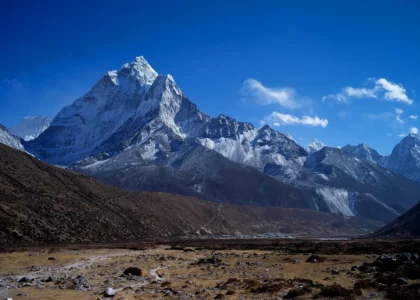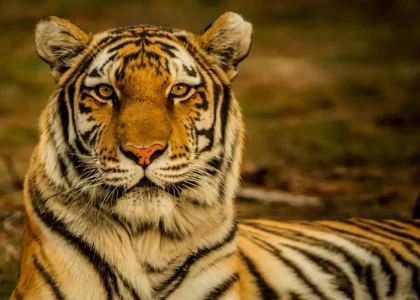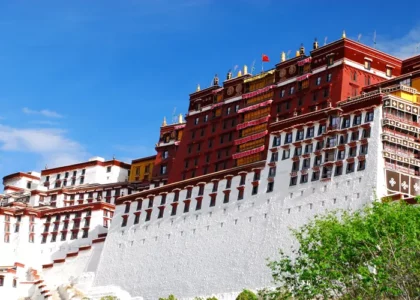A Traveler’s Guide to Pheriche: Altitude, Lodges, and Local Life

Introduction
Pheriche is a beautiful village at a high altitude located in the Nepal Khumbu region. It is only a small resting spot at an altitude of approximately 4,240 meters, and serves effectively as a resting place for the trekkers on the most famous trail, the Everest Base Camp.
This village is located under the mountainous, grandiose Ama Dablam peak that reaches a height of 6,812 meters. The scenic location of Pheriche also makes it a nearby place to Dingboche, which is another crucial settlement that has been very popular with trekkers venturing deep into the Himalayan massif.
Hiking in Pheriche is a scenic experience and a peaceful time in the midst of the grueling paths. Its lodges are comfortable and warm, and they offer much-needed rest to the trekkers in the thin air of the mountain at this altitude.
Pheriche serves as a very important acclimatization place. Trekkers take time to acclimate themselves physically, and equip themselves to the mounting demands that rise with elevation as they move onwards towards the Everest Base Camp and beyond.
Geography and Altitude
Pheriche falls in the Imja Khola Valley of Sagarmatha National Park, which is a UNESCO World Heritage Site. Its location at the heart of the Everest region offers stunning views of the Himalayan ranges and pristine surroundings.
The village is located at an elevation of about 4,240 meters (13,910 feet) above sea level. The air pressure and oxygen levels are lower, so trekkers must acclimatize carefully to prevent altitude sickness.
The landscape near Pheriche is mountainous with dramatic mountains and yak pastures where local herders graze livestock. Glacial waters also cut river valleys that add to the beautiful and varied mountain landscape of the area.
The climate is chilly and mostly windy, especially during the morning and evening. This extreme climate demands warm clothing and sturdy shelter because the weather can be very cold even in the daytime, despite the sunshine.

Getting to Pheriche
The standard trekking route to Pheriche begins at Namche Bazaar, after which it moves to Tengboche, Pangboche, and lastly to Pheriche. The route passes through the historic Sherpa villages and provides a unique cultural experience, and the Nepal Himalayas with a breathtaking scenic view.
The adventure between the two visits usually includes a number of hiking hours every day. As an example, the Namche bazaar to Tengboche is estimated to take 4.5 hours, and the trip between Pangboche and Pheriche takes an estimated few hours, which will enable the trekker to have a gradual uphill pace.
On the way, climbers will pass suspension bridges across rivers, rhododendron forests in blossom, and unique Sherpa villages. The scenic diversity of this trek makes the journey worth remembering, as the mountainous scenery and nature with its beauty accompany every single step.
Safety has to be taken into account. This is a gradual climb that allows the trekkers to settle in and gradually acclimatize, correctly avoiding the possibility of altitude sickness as their bodies get used to higher altitudes, taking them to Everest Base Camp and to greater heights.
Accommodation and Lodges
Pheriche has several teahouses and lodges where simple yet comfortable accommodation is available to trekkers. Basic amenities include shared rooms and bathrooms. Most lodges have dining halls that are heated and have a simple Wi-Fi connection, although it is not always stable.
The Himalayan Hotel, The White Yak Mountain Hut, and Snowland Lodge are popular lodges that are hospitable. They offer a homely feel and genuine Sherpa hospitality, where your high-altitude trekking experience is going to improve in Pheriche.
Hot meals are very common and include both the traditional Sherpa food and the simple bakery food. There is minimal electricity used to light and charge devices; hot showers are provided, which, at times, come at an extra fee.
Due to logistical difficulties, prices are likely to increase a small percentage with altitude. Electronic payment options are not prevalent in Pheriche; therefore, cash payment is preferred. By remaining in these lodges, you have an opportunity of rest and acclimatizing with ease.
Local Life and Culture
The Sherpa people of Pheriche lead a strong life that has evolved in accordance with the extreme conditions of the Himalayas. These people live their lives around the yak herding, farming, and lodge management of trekkers. Trekking seasons make Sherpa men act as guides and porters.
The Sherpa culture is founded on hospitality. Even though the mountain environment is quite difficult to navigate, the local community is eager to meet the visitors, provide simple yet nutritious food, and tell the tales of the mountain culture and climbing experience.
Pheriche is a town in which local life is tightly connected with Tibetan Buddhism. Protection, blessings, and harmonious spiritual unity with nature are common in the village, manifested by mani walls, chortens (stupas), and colorful prayer flags.
These cultural identities indicate the deep spiritual attachment to their landscape. Rituals and festivals are some of the major aspects of community life that promote high levels of community bonding and resilience in this distant mountain village. These cultural experiences make the trek even more meaningful beyond the physical challenge.
Health and Acclimatization
This is an important medical and acclimatizing point at an elevation of 4,371 meters on the Everest Base Camp Trek. Its position enables trekkers to take a break and acclimatize to the thinner air before proceeding to high altitudes, which has reduced chances of being affected by altitude sickness.
An aid post used by the Himalayan Rescue Association (HRA) provides much-needed medical help and training on altitude sickness at this site. This clinic will be important in cases where trekkers require assessment, care, or counseling throughout their climb in the Everest area.
For acclimatization, the trekkers are advised to practice rest days, keep hydrated, and have short hikes around the vicinity, including to the Nangkartshang Peak. The practices aid the body in adapting slowly to the decreased oxygen levels.
The symptoms of altitude sickness are headaches, nausea, dizziness, fatigue, and shortness of breath. The prevention measures aim at slow ascending, hydration, balanced dieting, and understanding of initial indicators to seek immediate health care the needed.
Nearby Attractions and Day Hikes
Pheriche presents several minor acclimatizations to the nearby ridges, and these would suitably assist trekkers to acclimatize themselves to altitude. The hike provides breathtaking panoramas, making it rewarding.
One of the most popular day hikes out of Pheriche is to the Nangkartshang Peak (5,083 meters) to have awesome views and significant physical attraction. The trail demonstrates amazing scenery of Ama Dablam and other Himalayan giants.
Another alternative is to visit Dingboche. The village is a classic Sherpa village with cultural values and the splendid Mountain View, which is a nice contrast to the rough hiking around Pheriche.
There are many scenic photography locations that surround Pheriche, including famous mountain peaks like Ama Dablam, Lhotse, and Imja Valley. Such views offer some of the best photo spots to those who love nature and mountaineering in general.
The culture of Sherpa Hospitality and Teahouse
Pheriche demonstrates the hospitality of the Sherpa people, who welcome the trekkers with cordial smiles, warm food, and comfortable lodges. Their service is inclined to the profound traditions of the mountains and high values of the community, which characterize the Himalayan traveling charm.
Pheriche teahouses offer simple rooms, traditional meals such as dal bhat, and warm group-style dining halls where trekkers exchange stories. Sherpa families are comfortable, warm, and positively kind even when in difficult high-altitude conditions.
Conversations with the owners of lodges largely tend to bring forth motivational climbing stories, cultural values, and personal encounters in the Khumbu valley. These activities ensure that evenings are not forgotten as they make trekkers associate with the culture of the mountain and feel at home in the Himalayas.
High-Altitude Environment and Weather
Pheriche is characterized by cold, dry, and windy weather because of the high elevation. It may get very cold, even on sunny days, and trekkers should be ready for the fact that the weather may change suddenly and the strong afternoon winds may blow across the valley.
Here, warm down jackets, gloves, windproof outs, and good trekking boots are required. The evenings are chilly, sometimes below zero degrees, hence sleeping bags rated for low temperatures provide warmth to the nights in the Himalaya.
The rough topography, river glaciers, wind of ice, and snowy passes put emphasis on the actual alpine condition. The exposure to these uncivilized elements of nature would make trekkers have a better understanding of life in the mountains and how difficult it is to live in high altitudes.
Best Time to Visit
Everest Base Camp can be best visited in spring (March–May) and autumn (September–November), which is the most predictable time of the year with the most impressive views. The spring is the season of blooming rhododendrons and mild weather, which is suitable for going hiking.
Weather conditions are quite pleasant during spring (March-May), with clear skies. There is a blooming of rhododendrons, making the landscape colorful, with temperatures at the lower altitudes favorable to trekking activities.
The winter (December-February) is cold and has more difficult weather and fewer trekkers. During winter, snow blocks the paths and impairs visibility, making winter less suitable for most trekkers.
Heavy rain and clouds, as well as low visibility, are experienced during the monsoon season (June-August). It makes the trails muddy and slippery, further increasing the risk of landslides and trail closure, thus not a good time to go trekking during these months.
Practical Travel Tips
When traveling to Pheriche and beyond, bring sufficient Nepali rupee cash, as there are no ATMs in this remote location. Cash is the customary method of payment for itineraries and shops for general purchases.
Be sure to wear layers so you can adapt to the fast-changing temperatures. Days can be quite warm, but once the sunset occurs, be prepared for significant cooling. It is essential to be comfortable in cold mountain environments, which is made easier by layering.
Bring portable chargers and additional batteries suitable for cold temperatures, as electronics will drain fast on low batteries. You will need to have phones, cameras, and electronic devices charged every evening after your trek.
Be mindful to dress modestly and behave respectfully at cultural sites, including monasteries. Being aware of the local traditions, customs, and norms reflects an appreciation for Sherpa culture, traditions, and respects fragile sacred space.
Be environmentally-conscious while trekking in Nepal, and avoid single-use plastic bottles. Use refillable water bottles equipped with a purification method, limit waste, and engage in responsible tourism practices that can help support the pristine environment of Pheriche and Sagarmatha National Park.
Conclusion
Pheriche’s allure lies in its tranquil and picturesque setting along the Everest trail surroundings. It is located under stunning peaks, providing guests a gentle escape from life, enriched by natural beauty and Sherpa culture, as well as an important acclimatization stop for trekkers.
Visiting Pheriche invites everyone to slow down, recover, and take in the undisturbed pastoral calm. This stop offers the gift of physiological accommodation and the comfort of allowing the mind to rest between silent moments of beauty amid the stunning Himalayan scenery and authentic Sherpa hospitality. In Pheriche, the Himalayas whisper peace, and every breath reminds you how high you’ve come.
Best Price Guaranteed, Easy to change Date, Instant Confirmation
Book This Trip Have Questions?
Have Questions?Talk to Expert
Meet Mr. Purushotam Timalsena (Puru), Nepal's best trek and tour organizer, who has been working in the Himalayas for more than 24 years.
WhatsApp/Viber +977 98510 95 800











